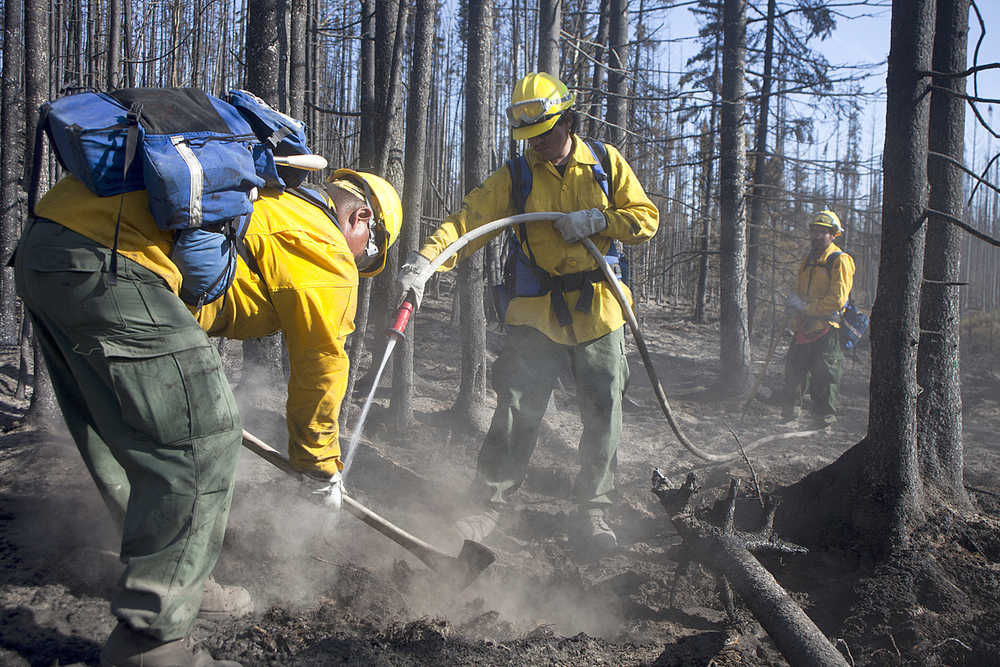This year’s fire season is off to a strong start on the Kenai Peninsula, and the Alaska Division of Forestry and local fire departments are preparing by training and stressing burn permit regulations to the public.
The Division of Forestry and local fire agencies have responded to 16 wildfires or illegal cases of burning since April 1 on the peninsula, according to a release from the Alaska Department of Natural Resources sent out Monday.
“The lack of snow cover, coupled with standing dead grass, has greatly enhanced the fire danger, particularly in areas along main highway corridors,” officials wrote in the release.
The Division of Forestry issued a burn permit suspension for the Kenai Peninsula that lasted throughout Monday and was lifted at 8 a.m. Tuesday, and Kenai issued its own for the city for the same time period. Most of the fires have been caused by people not following the guidelines on the general burn permits issued by the state, according to the release.
Dan Govoni, fire prevention officer for the division’s Kenai-Kodiak Area office, said the issues don’t seem to be with those who read and follow their permits, but with those who either don’t study them closely enough or fail to get them in the first place. Burn permits are free and can be picked up a fire stations and Division of Forestry offices in Soldotna and Homer, or downloaded online at forestry.alaska.gov/burn, according to the release.
“From what I’ve seen, the most common mistakes we run into are people who have burn barrels that are not in compliance … people that are burning items other than untreated wood and paper … and then not staying with their fire the entire time, and then a lack of clearance around the fire,” Govoni said.
The Alaska Interagency Coordination Center’s monthly outlooks for the state’s fire potential predict that the Anchorage Bowl, the Mat-Su Valley and the Kenai Peninsula will have above average fire conditions in May. Fire conditions should go back to normal by June, which Division of Forestry Public Information Officer Tim Mowry said means precipitation for the area will return to normal levels, based on the climate models used to create the outlooks.
After things “green up,” the likelihood that fires will be caused by humans goes down because potential fuel sources will be less receptive, Mowry said. Later in the fire season, the chances of a wildfire starting are more dependent on weather conditions, he said.
“A lot of it is dependent on the amount of lightning we get,” Mowry said, explaining that, traditionally, lightning is less common on the Kenai Peninsula.
While the Card Street fire was raging through Sterling last June, two smaller fires were being battled in the Cooper Landing area, both ignited by lightning strikes. Even though fire conditions should return to normal this June, Mowry said the areas in question won’t be totally out of the woods.
“Even if we get rain, you know, a little bit of rain doesn’t put a fire out,” he said. “If you get a week of hot, dry, windy weather, all that rain sort of goes out the door and you’re back to square one.”
Members of the Division of Forestry and local firefighters have been preparing for these conditions. Mowry said crews from around the state have finished or are going through 80-hour training sessions to make sure they are up on their wildfire education. This includes things like using chain saws and other skills needed when fighting wildland fires, he said.
Members of the Kenai Fire Department are also trained up and ready for potential wildland fires, said Kenai Fire Chief Jeff Tucker.
Based on years past, Govoni estimated the Division of Forestry generally puts out 1,500–2,000 permits annually, without distinguishing for which are actually activated and excluding Homer and Kenai, which both put out their own permits. The City of Kenai works with a year-round permit system, Tucker said, so that anyone within city limits who wants to burn at any time of year needs to get a permit.
Residents in Kenai must also get their burn permits in person, which Tucker said gives firefighters an opportunity to educate them and answer questions they might have about burning rules.
Mowry said the Kenai Peninsula will see increased traffic during summer months in relation to the fisheries. While he said the Division of Forestry can’t always afford to increase its manpower during peak months, it does increase its educational efforts through brochures and public service announcements.
Tucker said that while the Kenai Fire Department is separate from the Division of Forestry, it works closely with it an other peninsula agencies like Central Emergency Services to keep tabs on what is going on in terms of fire conditions.
“We’ll pay close attention to what people are doing,” Tucker said of the busy summer season.
Monday’s burn suspension prohibited all burning besides campfires, but Tucker said those can be dangerous too, especially on the beaches where dry bluff grasses are not far away.
“If someone’s out burning, even a camp fire, make sure it’s cool to the touch before you leave,” he advised.
Govoni said permit holders still need to call in to (907) 269-4269 every time they plan to burn, before they burn, and that they are encouraged to call back throughout the day to see if conditions have changed enough that they need to stop burning. People calling in no longer need to leave their addresses as they were required to in the past, he said.
Reach Megan Pacer at megan.pacer@peninsulaclarion.com.

